Synthesis of a radar recognition algorithm with ability to meet reliability of decisions
Some methods that try to improve the information collection and reduce the priori
inconsistence in radars demanding systematic complication and high price [1, 4, 7-9]. In
other words, by results of the limitation of technology those methods only support the
recognition improvement in general but cannot satisfy specific practical conditions.
Another approach that prolongs the observation cycle to gather a mass of information
for classification. Several previous works applied this way, for example, multi-step
decisions based on the sequential analysis theorem, however, their results have been
limited to the detection problem ( L 2 ), and the recognition problem ( L 2 ) needs to
be researched further [2, 3, 5, 6, 10, 13]. Besides, the observation cycle cannot be too
long; thus, that measure is also unfeasible. In that case, a common solution in most
researches is “if the observation cycle has reaches the limited value but no final result
returned by the sequential algorithm, then the unsatisfied quality acceptance are
informed and the regular one-step decision rule is applied”.
On purpose “guarantee reliability of decisions”, this paper focuses on:
- Synthesizing a sequential (multi-step) algorithm of radar recognition and
decision-making solution if the observation cycle is critical.
- Analyzing and evaluating the algorithm quality.
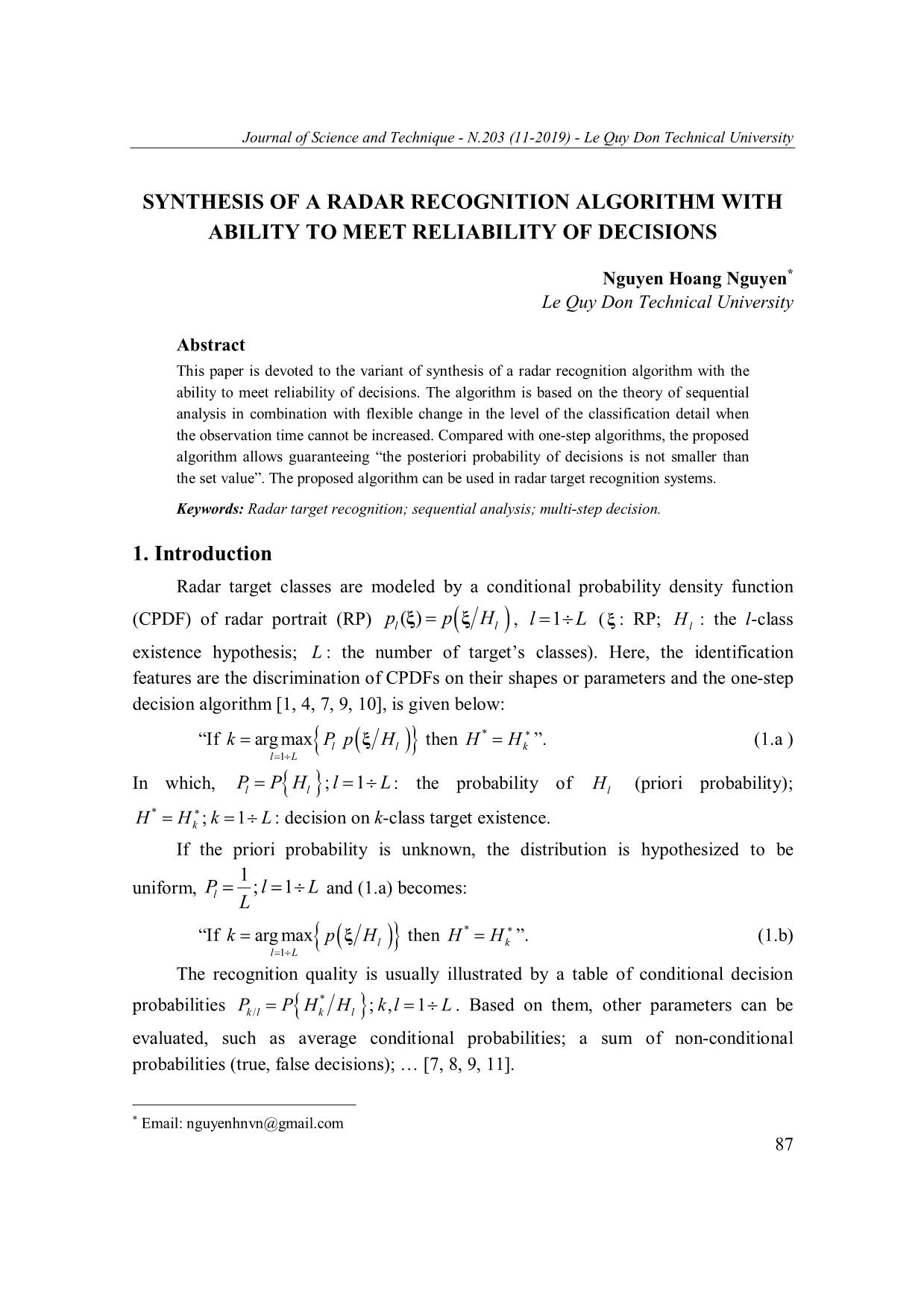
Trang 1

Trang 2
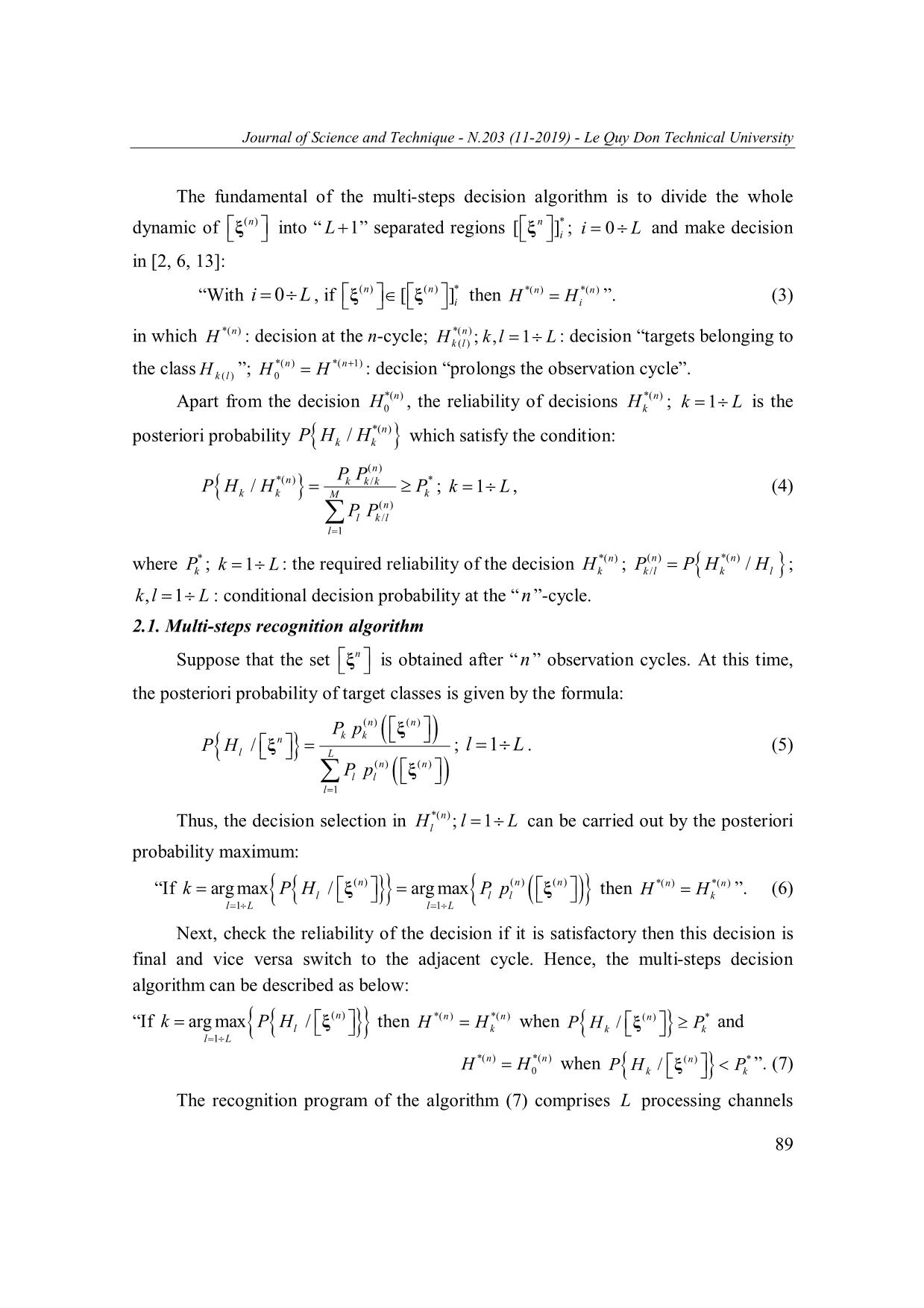
Trang 3
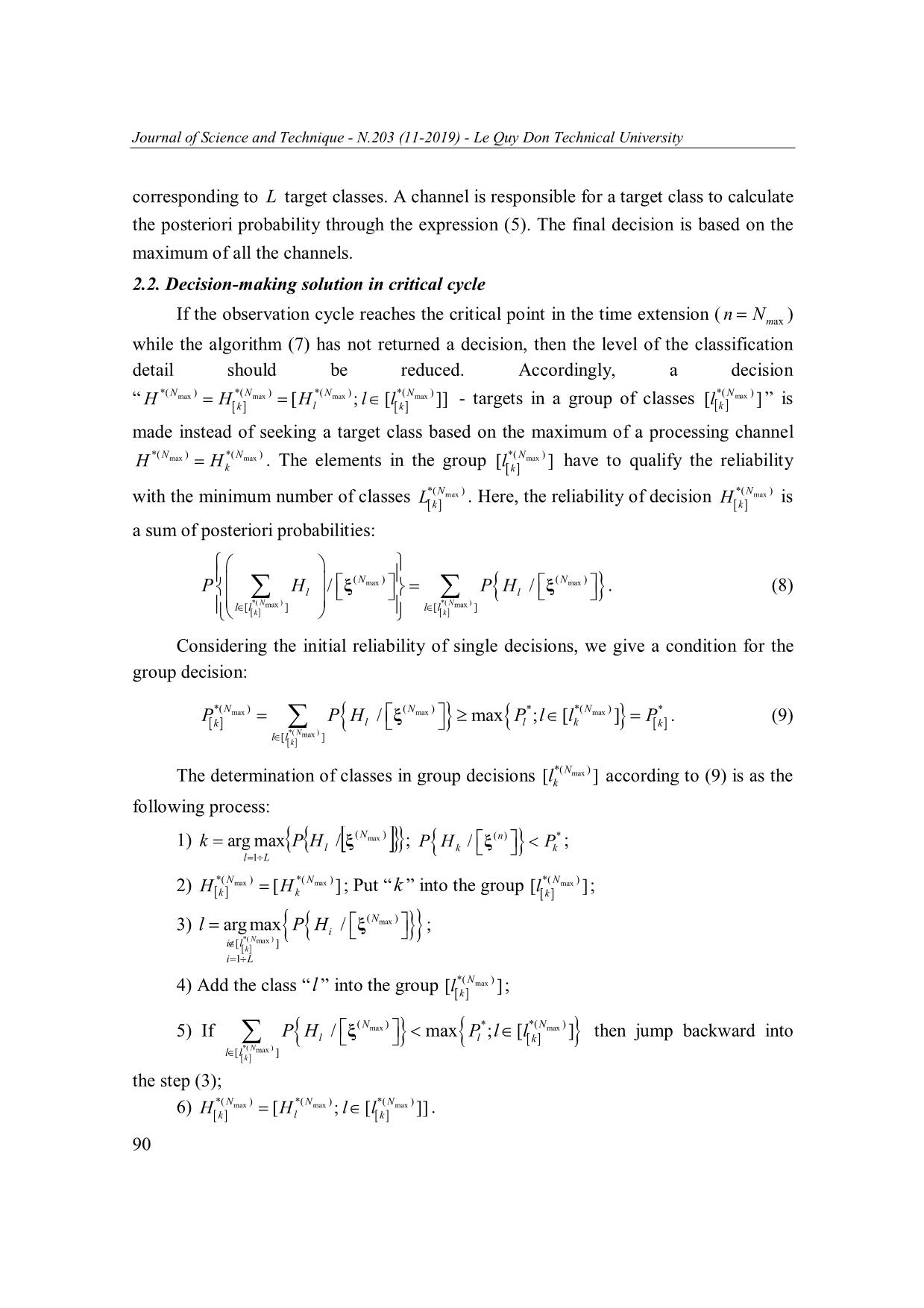
Trang 4
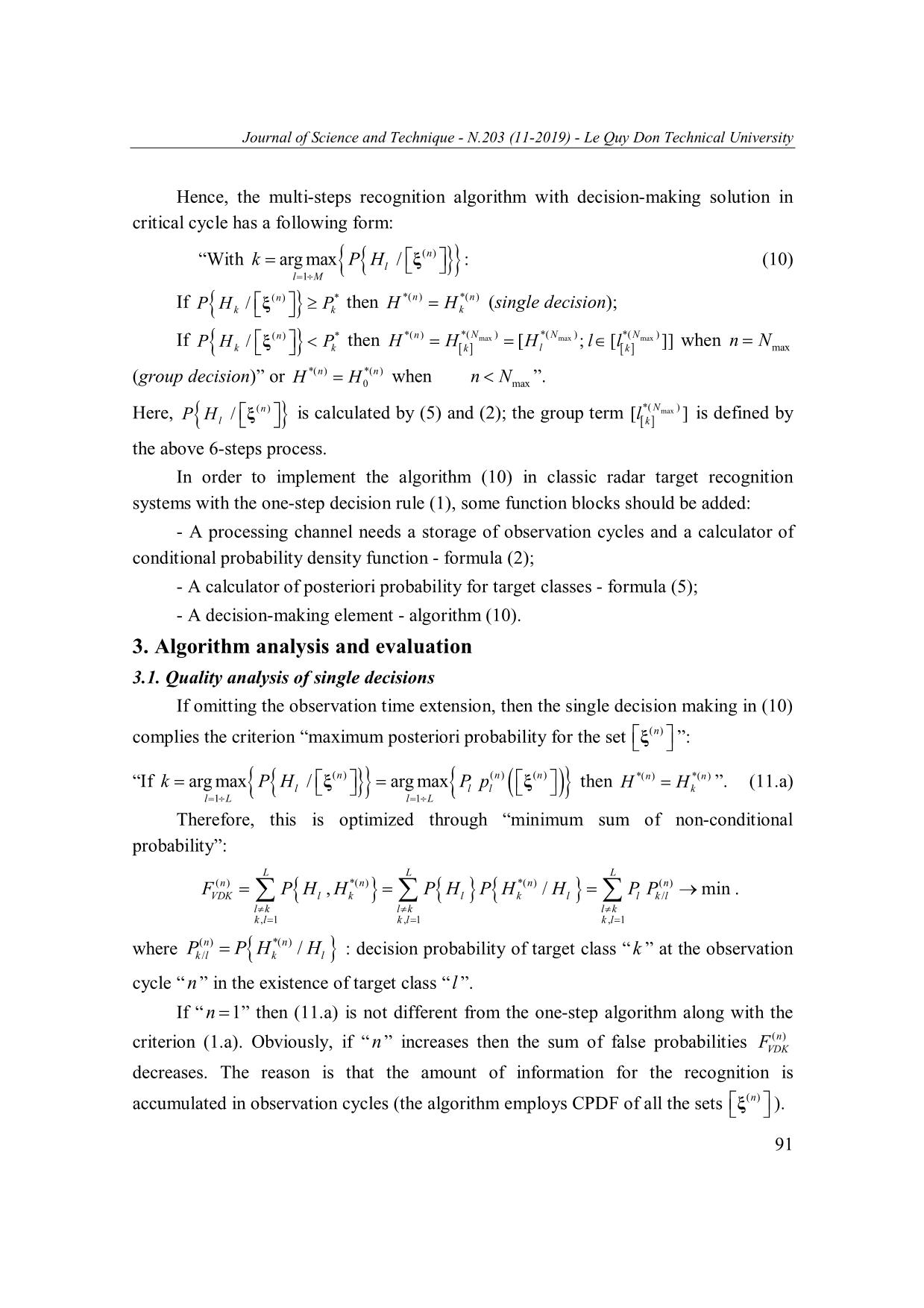
Trang 5
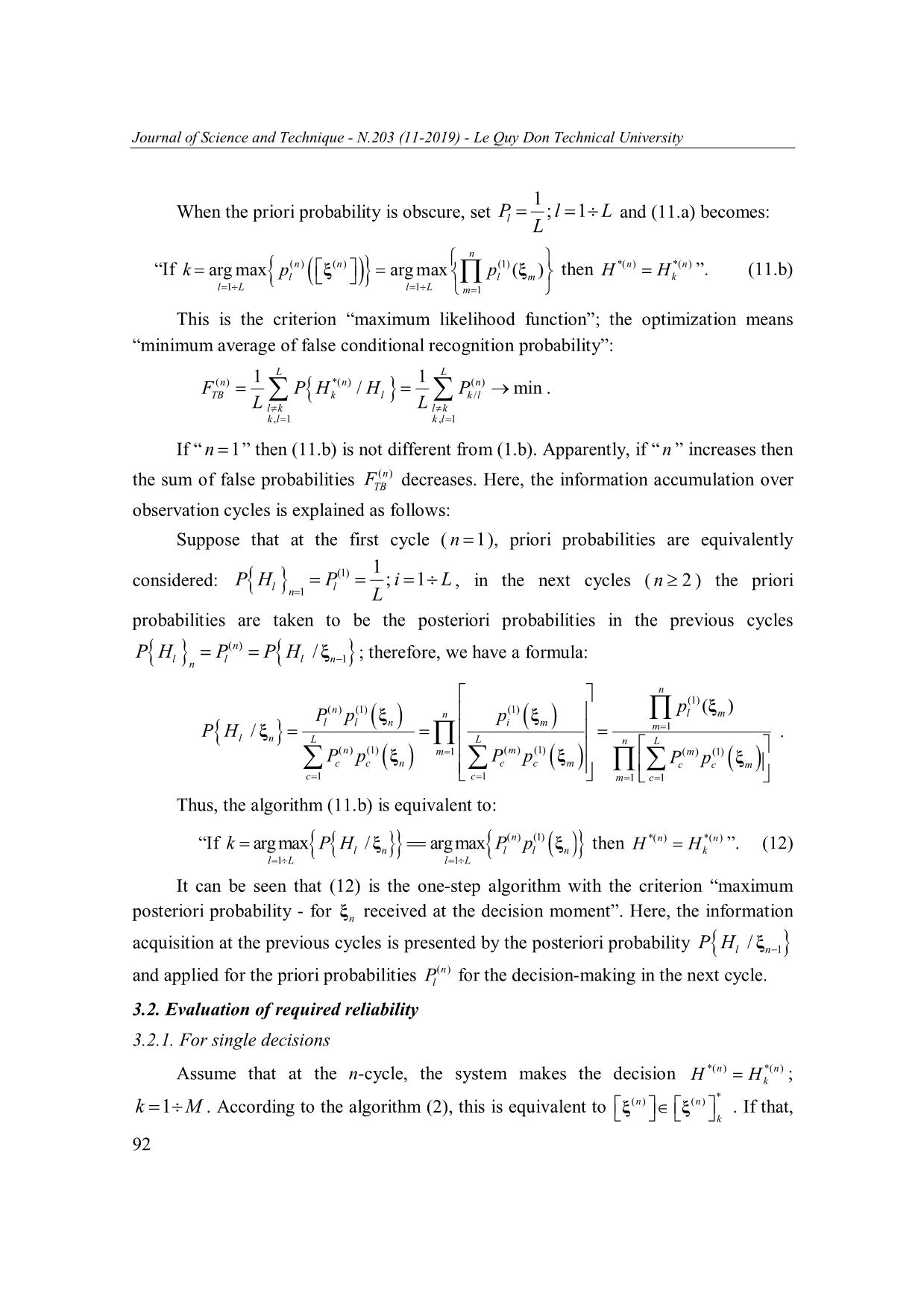
Trang 6
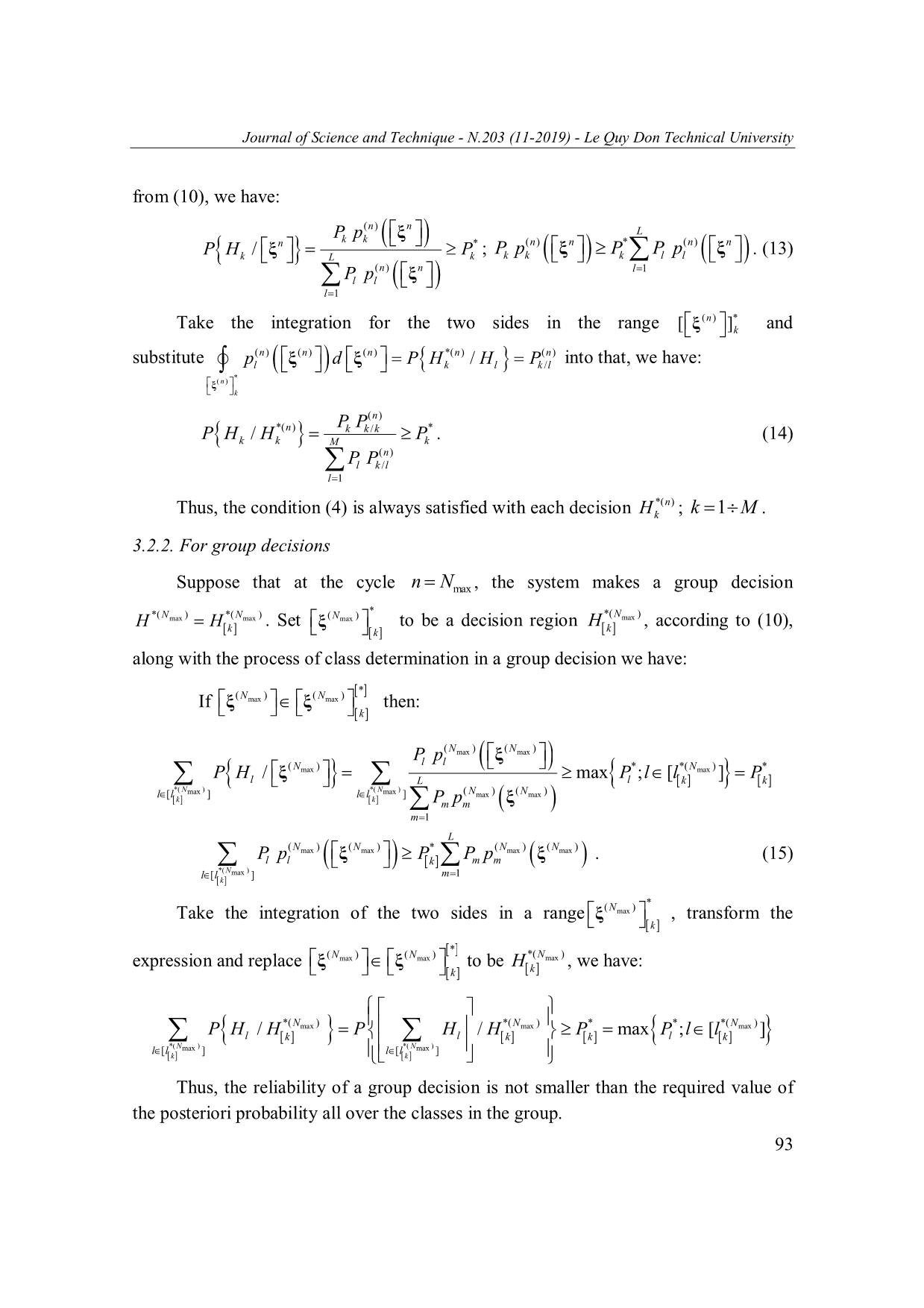
Trang 7
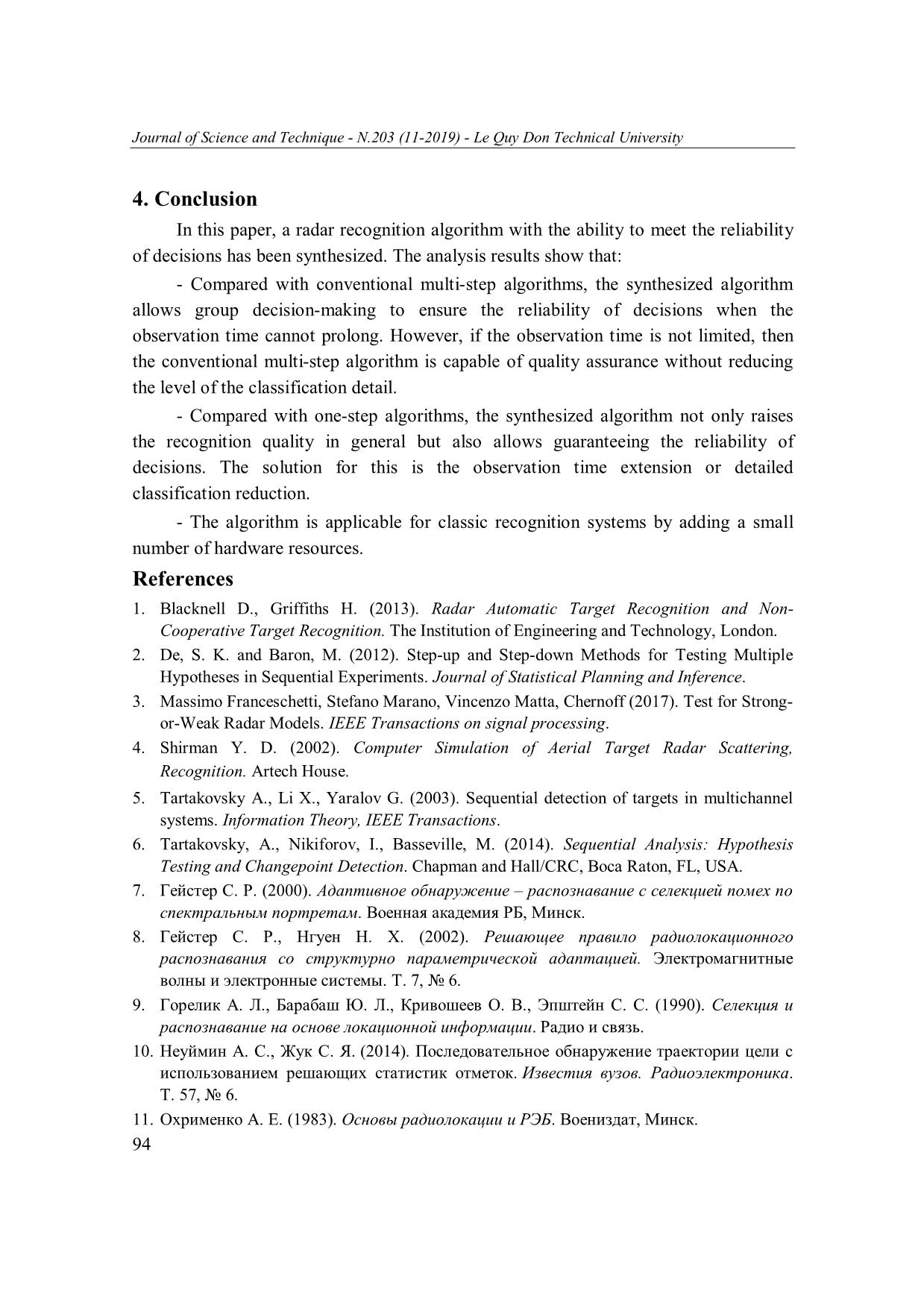
Trang 8
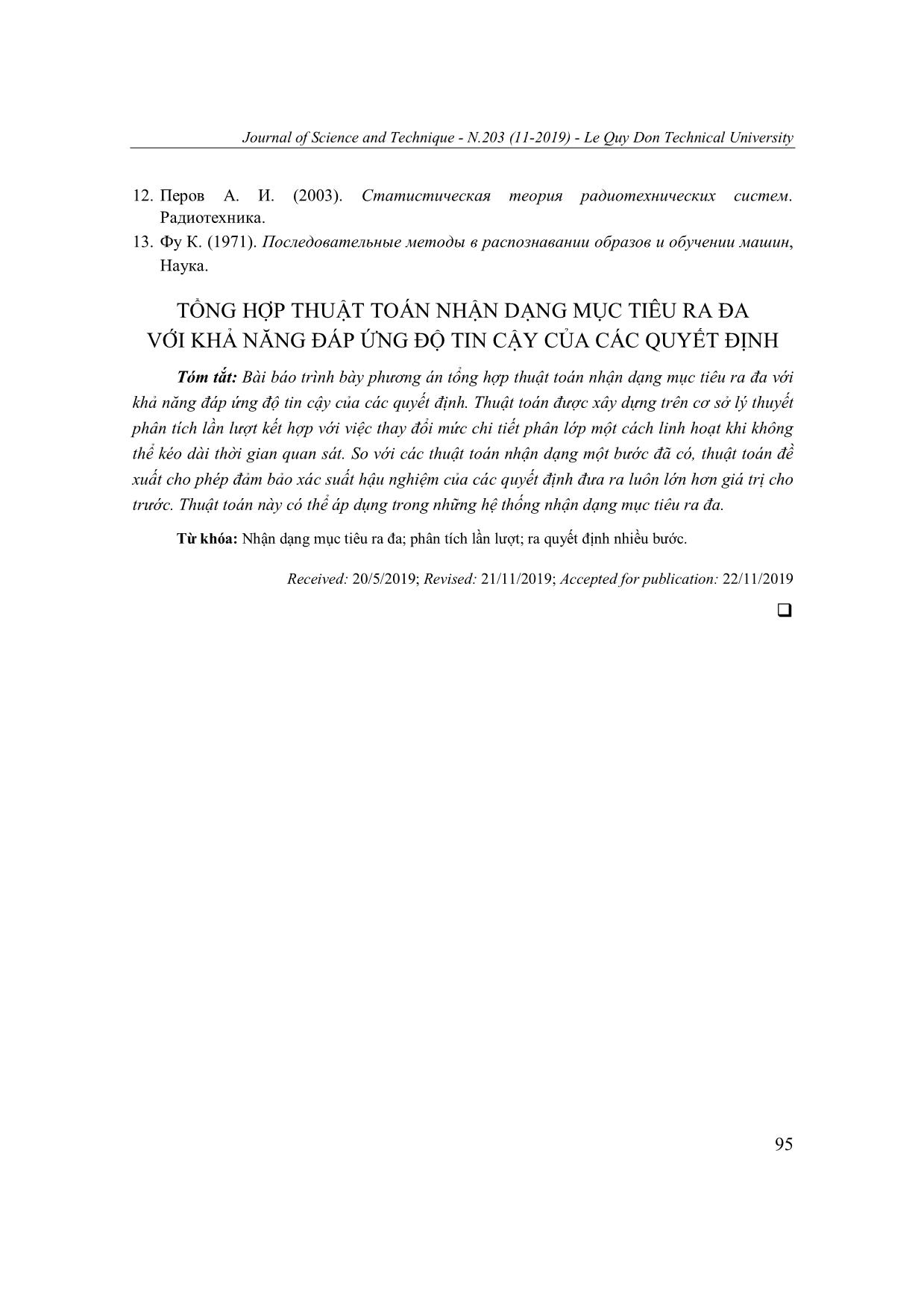
Trang 9
Tóm tắt nội dung tài liệu: Synthesis of a radar recognition algorithm with ability to meet reliability of decisions
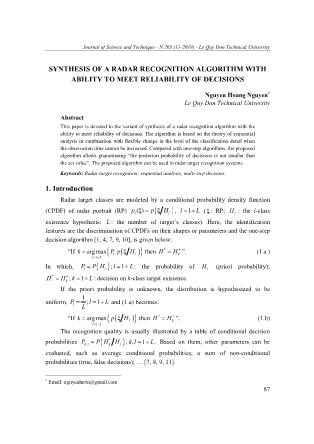
nd the recognition problem ( L 2 ) needs to be researched further [2, 3, 5, 6, 10, 13]. Besides, the observation cycle cannot be too long; thus, that measure is also unfeasible. In that case, a common solution in most researches is “if the observation cycle has reaches the limited value but no final result returned by the sequential algorithm, then the unsatisfied quality acceptance are informed and the regular one-step decision rule is applied”. On purpose “guarantee reliability of decisions”, this paper focuses on: - Synthesizing a sequential (multi-step) algorithm of radar recognition and decision-making solution if the observation cycle is critical. - Analyzing and evaluating the algorithm quality. 2. Algorithm synthesis In the radar target recognition, the observation cycle extension is equivalent to the increase in the number of contacts with targets. Call ξm to be RP at the cycle “ m ” (n) ( m 1,2...), then after the n-cycle, there are a set of “n ” RPs ξ ξ1 ,ξ2 ,,ξ n . Generally, due to the large observation cycle compared with the signal fluctuation, the ()n RP can be considered independently and the PDF of the set ξ is given by [7-9, 11]: n (n ) ( n ) ( n ) (1) pl ξ p ξ H l p l() ξ m , (2) m 1 (1) where pl(ξ m ) p ( ξ m H l ); l 1 L : CPDF of the H l -class of targets at the m-observation cycle. 88 Journal of Science and Technique - N.203 (11-2019) - Le Quy Don Technical University The fundamental of the multi-steps decision algorithm is to divide the whole ()n n * dynamic of ξ into “ L 1” separated regions [] ξ i ; i 0 L and make decision in [2, 6, 13]: ()()*n n *(n ) *( n ) “With i 0 L , if ξ [] ξ i then HH i ”. (3) *(n ) *(n ) in which H : decision at the n-cycle; Hk() l ; k , l 1 L : decision “targets belonging to *(n ) *( n 1) the class H k() l ”; HH0 : decision “prolongs the observation cycle”. *(n ) *(n ) Apart from the decision H0 , the reliability of decisions H k ; k 1 L is the *(n ) posteriori probability PHH k/ k which satisfy the condition: ()n *(n )PPk k/ k * PHHP k/ k M k ; k 1 L , (4) ()n PPl k/ l l 1 * *(n ) (n ) *( n ) where Pk ; k 1 L : the required reliability of the decision H k ; PPHHk/ l k/ l ; k, l 1 L : conditional decision probability at the “n ”-cycle. 2.1. Multi-steps recognition algorithm n Suppose that the set ξ is obtained after “n ” observation cycles. At this time, the posteriori probability of target classes is given by the formula: P p()()n ξ n n k k PH / ξ ; l 1 L . (5) l L ()()n n Pl p l ξ l 1 *(n ) Thus, the decision selection in Hl ; l 1 L can be carried out by the posteriori probability maximum: “If k arg max P H / ξ()()()n arg max P p n ξ n then *(n ) *( n ) ”. (6) l l l HH k l 1 L l 1 L Next, check the reliability of the decision if it is satisfactory then this decision is final and vice versa switch to the adjacent cycle. Hence, the multi-steps decision algorithm can be described as below: “If k arg max P H / ξ()n then HH*(n ) *( n ) when ()*n and l k PHP k/ ξ k l 1 L HH*(n ) *( n ) when PHP/ ξ()*n ”. (7) 0 k k The recognition program of the algorithm (7) comprises L processing channels 89 Journal of Science and Technique - N.203 (11-2019) - Le Quy Don Technical University corresponding to L target classes. A channel is responsible for a target class to calculate the posteriori probability through the expression (5). The final decision is based on the maximum of all the channels. 2.2. Decision-making solution in critical cycle If the observation cycle reaches the critical point in the time extension ( n Nmax ) while the algorithm (7) has not returned a decision, then the level of the classification detail should be reduced. Accordingly, a decision *(NNNNmax ) *( max ) *( max ) *( max ) *( N max ) “ H Hk [ Hl ; l [ l k ]] - targets in a group of classes [lk ] ” is made instead of seeking a target class based on the maximum of a processing channel *(NNmax ) *( max ) *(Nmax ) HH k . The elements in the group []lk have to qualify the reliability *(Nmax ) *(Nmax ) with the minimum number of classes Lk . Here, the reliability of decision Hk is a sum of posteriori probabilities: ()()NNmax max . (8) PHPH l// ξ l ξ l [][] l*(NNmax ) l l *( max ) k k Considering the initial reliability of single decisions, we give a condition for the group decision: P*(NNNmax ) P H/ ξ ( max ) max P** ; l [ l *( max ) ] P . (9) k l l k k l [] l*(Nmax ) k *(Nmax ) The determination of classes in group decisions []lk according to (9) is as the following process: (N ) 1) k arg max P H / ξ max ; ()*n ; l PHP k/ ξ k l 1L *( Nmax ) *( Nmax ) *(Nmax ) 2) H k [H k ]; Put “k ” into the group []lk ; 3) l arg max P H / ξ()Nmax ; i i [] l*(Nmax ) k i 1 L *(Nmax ) 4) Add the class “l ” into the group []lk ; 5) If P H/ ξ(NNmax ) max P* ; l [ l *( max ) ] then jump backward into l l k l [] l*(Nmax ) k the step (3); *(NNNmax ) *( max ) *( max ) 6) Hk [ Hl ; l [ l k ]] . 90 Journal of Science and Technique - N.203 (11-2019) - Le Quy Don Technical University Hence, the multi-steps recognition algorithm with decision-making solution in critical cycle has a following form: “With k arg max P H / ξ()n : (10) l l 1 M If ()*n then HH*(n ) *( n ) (single decision); PHP k/ ξ k k *(NNN ) *( ) *( ) If ()*n then H*(n ) Hmax [ H max ; l [ l max ]] when n N PHP k/ ξ k k l k max *(n ) *( n ) (group decision)” or HH 0 when n Nmax ”. *(N ) Here, ()n is calculated by (5) and (2); the group term []l max is defined by PH l / ξ k the above 6-steps process. In order to implement the algorithm (10) in classic radar target recognition systems with the one-step decision rule (1), some function blocks should be added: - A processing channel needs a storage of observation cycles and a calculator of conditional probability density function - formula (2); - A calculator of posteriori probability for target classes - formula (5); - A decision-making element - algorithm (10). 3. Algorithm analysis and evaluation 3.1. Quality analysis of single decisions If omitting the observation time extension, then the single decision making in (10) ()n complies the criterion “maximum posteriori probability for the set ξ ”: “If k arg max P H / ξ()()()n arg max P p n ξ n then *(n ) *( n ) ”. (11.a) l l l HH k l 1 L l 1 L Therefore, this is optimized through “minimum sum of non-conditional probability”: LLL (n ) *( n ) *( n ) ( n ) FPHHPHPHHPPVDK lk, l kl / lkl/ min . l k l k l k k, l 1 k , l 1 k , l 1 (n ) *( n ) where PPHHk/ l k/ l : decision probability of target class “k ” at the observation cycle “ n ” in the existence of target class “l ”. If “ n 1” then (11.a) is not different from the one-step algorithm along with the ()n criterion (1.a). Obviously, if “n ” increases then the sum of false probabilities FVDK decreases. The reason is that the amount of information for the recognition is ()n accumulated in observation cycles (the algorithm employs CPDF of all the sets ξ ). 91 Journal of Science and Technique - N.203 (11-2019) - Le Quy Don Technical University 1 When the priori probability is obscure, set P ; l 1 L and (11.a) becomes: l L n “If k argmax p(n ) ξ ( n ) argmax p (1) () ξ then HH*(n ) *( n ) ”. (11.b) l l m k l 1 L l 1 L m 1 This is the criterion “maximum likelihood function”; the optimization means “minimum average of false conditional recognition probability”: LL (n )1 *( n ) 1 ( n ) FPHHPTB k/ l k/ l min . LLl k l k k, l 1 k , l 1 If “ n 1” then (11.b) is not different from (1.b). Apparently, if “ n ” increases then the sum of false probabilities F ()n decreases. Here, the information accumulation over TB observation cycles is explained as follows: Suppose that at the first cycle ( n 1), priori probabilities are equivalently (1) 1 considered: P Hl P l ; i 1 L , in the next cycles ( n 2 ) the priori n 1 L probabilities are taken to be the posteriori probabilities in the previous cycles PHPPH ()n / ξ ; therefore, we have a formula: ln l l n 1 n (1) (n ) (1) (1) p ()ξ P pξn p ξ l m l l n i m m 1 PH l/ ξ n LL . n L P(n ) p (1)ξm 1 P ( m ) p (1) ξ P ( m ) p (1) ξ c c n c c m c c m c 1 c 1 m 1 c 1 Thus, the algorithm (11.b) is equivalent to: (n ) (1) *(n ) *( n ) “If k argmax P Hl /ξ n argmax P l p l ξ n then HH k ”. (12) l 1 L l 1 L It can be seen that (12) is the one-step algorithm with the criterion “maximum posteriori probability - for ξn received at the decision moment”. Here, the information acquisition at the previous cycles is presented by the posteriori probability PH l/ ξ n 1 ()n and applied for the priori probabilities Pl for the decision-making in the next cycle. 3.2. Evaluation of required reliability 3.2.1. For single decisions *(n ) *( n ) Assume that at the n-cycle, the system makes the decision HH k ; * k 1 M . According to the algorithm (2), this is equivalent to ξ()()n ξ n . If that, k 92 Journal of Science and Technique - N.203 (11-2019) - Le Quy Don Technical University from (10), we have: P p()n ξ n L n k k * ()*()n n n n PHP/ ξ ; P p ξ P P p ξ . (13) k L k k k k l l ()n n l 1 Pl p l ξ l 1 Take the integration for the two sides in the range ()*n and [] ξ k substitute p()()n ξ n d ξ () n P H *() n/ H P () n into that, we have: l k l k/ l * ξ()n k ()n *(n )PPk k/ k * PHHP k/ k M k . (14) ()n PPl k/ l l 1 *(n ) Thus, the condition (4) is always satisfied with each decision H k ; k 1 M . 3.2.2. For group decisions Suppose that at the cycle n Nmax , the system makes a group decision *(NN ) *( ) * *(N ) HHmax max . Set ξ()Nmax to be a decision region H max , according to (10), k k k along with the process of class determination in a group decision we have: * If ξ()()NNmax ξ max then: k ()()NNmax max Pl p l ξ P H/ ξ(NNmax ) max P** ; l [ l *( max ) ] P l L l k k *(NN ) *( ) l []] lmax l l max ()()NNmax max k k Pm p m ξ m 1 L P p()()()()NNNNmax ξ max P* P p max ξ max . (15) l l k m m l [] l*(Nmax ) m 1 k * Take the integration of the two sides in a range ξ()Nmax , transform the k * *(N ) expression and replace ξ()()NNmax ξ max to be H max , we have: k k *(NNNmax ) *( max )** *( max ) P Hl/ Hk P H l / H k P k max P l ; l [ l k ] l [][] l*(NNmax ) l l *( max ) k k Thus, the reliability of a group decision is not smaller than the required value of the posteriori probability all over the classes in the group. 93 Journal of Science and Technique - N.203 (11-2019) - Le Quy Don Technical University 4. Conclusion In this paper, a radar recognition algorithm with the ability to meet the reliability of decisions has been synthesized. The analysis results show that: - Compared with conventional multi-step algorithms, the synthesized algorithm allows group decision-making to ensure the reliability of decisions when the observation time cannot prolong. However, if the observation time is not limited, then the conventional multi-step algorithm is capable of quality assurance without reducing the level of the classification detail. - Compared with one-step algorithms, the synthesized algorithm not only raises the recognition quality in general but also allows guaranteeing the reliability of decisions. The solution for this is the observation time extension or detailed classification reduction. - The algorithm is applicable for classic recognition systems by adding a small number of hardware resources. References 1. Blacknell D., Griffiths H. (2013). Radar Automatic Target Recognition and Non- Cooperative Target Recognition. The Institution of Engineering and Technology, London. 2. De, S. K. and Baron, M. (2012). Step-up and Step-down Methods for Testing Multiple Hypotheses in Sequential Experiments. Journal of Statistical Planning and Inference. 3. Massimo Franceschetti, Stefano Marano, Vincenzo Matta, Chernoff (2017). Test for Strong- or-Weak Radar Models. IEEE Transactions on signal processing. 4. Shirman Y. D. (2002). Computer Simulation of Aerial Target Radar Scattering, Recognition. Artech House. 5. Tartakovsky A., Li X., Yaralov G. (2003). Sequential detection of targets in multichannel systems. Information Theory, IEEE Transactions. 6. Tartakovsky, A., Nikiforov, I., Basseville, M. (2014). Sequential Analysis: Hypothesis Testing and Changepoint Detection. Chapman and Hall/CRC, Boca Raton, FL, USA. 7. Гейстер С. Р. (2000). Адаптивное обнаружение – распознавание с селекцией помех по спектральным портретам. Военная академия РБ, Минск. 8. Гейстер С. Р., Нгуен Н. Х. (2002). Решающее правило радиолокационного распознавания со структурно параметрической адаптацией. Электромагнитные волны и электронные системы. Т. 7, № 6. 9. Горелик А. Л., Барабаш Ю. Л., Кривошеев О. В., Эпштейн С. С. (1990). Селекция и распознавание на основе локационной информации. Радио и связь. 10. Неуймин А. С., Жук С. Я. (2014). Последовательное обнаружение траектории цели с использованием решающих статистик отметок. Известия вузов. Радиоэлектроника. Т. 57, № 6. 11. Охрименко А. Е. (1983). Основы радиолокации и РЭБ. Воениздат, Минск. 94 Journal of Science and Technique - N.203 (11-2019) - Le Quy Don Technical University 12. Перов А. И. (2003). Статистическая теория радиотехнических систем. Радиотехника. 13. Фу К. (1971). Последовательные методы в распознавании образов и обучении машин, Наука. TỔNG HỢP THUẬT TOÁN NHẬN DẠNG MỤC TIÊU RA ĐA VỚI KHẢ NĂNG ĐÁP ỨNG ĐỘ TIN CẬY CỦA CÁC QUYẾT ĐỊNH Tóm tắt: Bài báo trình bày phương án tổng hợp thuật toán nhận dạng mục tiêu ra đa với khả năng đáp ứng độ tin cậy của các quyết định. Thuật toán được xây dựng trên cơ sở lý thuyết phân tích lần lượt kết hợp với việc thay đổi mức chi tiết phân lớp một cách linh hoạt khi không thể kéo dài thời gian quan sát. So với các thuật toán nhận dạng một bước đã có, thuật toán đề xuất cho phép đảm bảo xác suất hậu nghiệm của các quyết định đưa ra luôn lớn hơn giá trị cho trước. Thuật toán này có thể áp dụng trong những hệ thống nhận dạng mục tiêu ra đa. Từ khóa: Nhận dạng mục tiêu ra đa; phân tích lần lượt; ra quyết định nhiều bước. Received: 20/5/2019; Revised: 21/11/2019; Accepted for publication: 22/11/2019 95
File đính kèm:
 synthesis_of_a_radar_recognition_algorithm_with_ability_to_m.pdf
synthesis_of_a_radar_recognition_algorithm_with_ability_to_m.pdf

